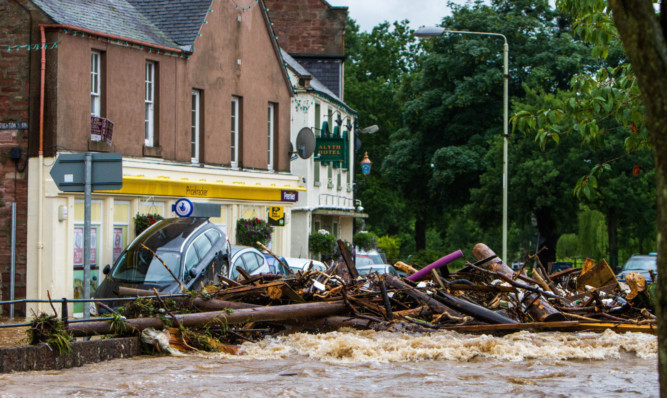A “one in 200-year” downpour caused the catastrophic flash flooding that submerged the Perthshire village of Alyth this year, a new report has revealed.
Theories that beavers contributed to the bursting of the Alyth Burn were ruled out by Perth and Kinross Council, the Scottish Environment Protection Agency (Sepa) and Scottish Natural Heritage (SNH), who released their joint verdict yesterday.
The report found a six-hour deluge of heavy rain coupled with a high flow in the burn was to blame for the July 17 incident which left more than 750 homes without power.
Dozens of properties had to be evacuated and several motorists were rescued from their vehicles as water rushed down the streets causing millions of pounds worth of damage
Around 60mm of rain fell inside six hours resulting in a peak flow in the burn of around 40 cubic metres per second.
The highest intensity of rainfall was between 4am and 8am, which is when the flooding began.
The high-flowing river caused trees to uproot, telegraph poles to fall, wood debris to collect and footbridges to collapse.
The report stated these things were not the cause of the flooding and that the incident would have still occurred if they had not been present.
Other items carried along in the flow included a skip, cut timber, general waste and several cars.
Local residents suggested beavers may have caused the floods after wood bearing teeth marks were spotted in the debris.
However, the report stated: “In response to concerns over the possible contribution by beavers to the scale of flooding, SNH contracted the Royal Zoological Society of Scotland (RZSS) to investigate.
“All beaver dams located along the stream network feeding into the Alyth Burn above the Den of Alyth were found to be intact with only minor damage to a few, which beavers had repaired with mud.
“While much of the flood-borne timber had been debarked and could appear to have been associated with beaver felling, close inspection found an absence of characteristic beaver tooth marks on the wood.
“RZSS concluded that beavers made little or no significant contribution to the flood.”
Pascal Lardet, Sepa flood unit manager, said: “Our joint investigations have shown that this event seems to have been the largest flood in Alyth over the last 140 years and was triggered by a very intense period of rain in the early morning of July 17.”
Councillor Ian Miller, leader of Perth and Kinross Council, said: “The conclusions from the report will provide a basis to develop potential measures to mitigate the impact of further severe flooding.”
